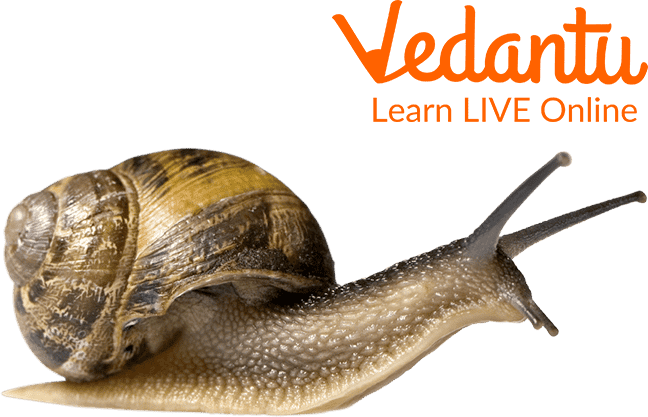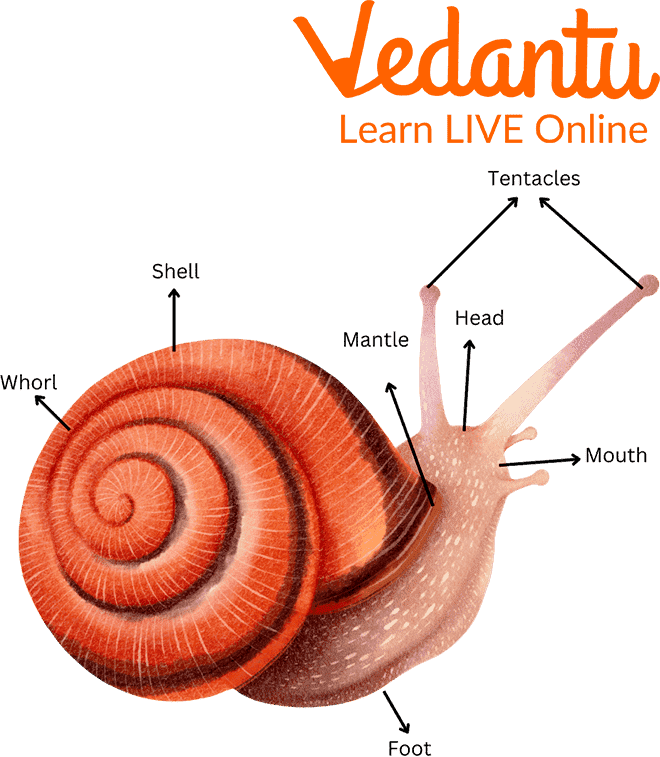




An Overview of Snail
Do you notice snails while at home? You might want one as a pet but have read an intriguing description of one. There are many different shades, forms, and sizes of snails. In this article, we are going to read about a snail, its appearance, habitat, and food.
It has a lengthy, moist, unsegmented, squishy, and slimy body. A hard shell typically surrounds the body to protect it. The snail's head, neck, visceral hump, tail, and foot are all parts of its body. A pair of tentacles or feelers are on the head. The snail's mouth is located below the lowest set of tentacles and in the middle of its head. These are some of the snail characteristics. Now, let’s understand more about snails.

Snail
Biology of Snails
By understanding their biology, you can learn a lot of interesting things about snails as a part of the natural world.
The mollusc family known as gastropods includes snails and slugs. The next time you see a snail, you can wow your buddies by remarking, "Wow! That gastropod is fantastic, isn't it?"
Snails are a type of mollusc, which is an animal group with a tough shell. Clams, oysters, and octopus are examples of other molluscs.
Scientists have discovered mummified snails that lived millions of years ago. They are one of the world's oldest animal species, in actuality. Snails have existed for more than 600 million years, according to most estimations.
Snails and slugs are both types of gastropods.
Snails are deaf. They use their sense of smell to locate food.
Slime is the trail that snails leave behind as they move. They are shielded by the slime as they move.
A snail is both male and female, thus there is no way to distinguish between the two! Due to their hermaphroditic nature, snails are able to both lay and fertilise female eggs (male).
Do snails sleep at night? Yes, it might surprise you to learn that most snails are nocturnal. The best chances of seeing them are at night or very early in the morning.
Snails can live for 15 to 20 years, which is probably for the best considering how long it might take them to cross the yard.
Characteristics of Snails
Since they are invertebrates, snails lack a backbone. The five basic components of a snail's body are its head, neck, visceral hump, tail, and foot.
The radula, or ribbon-like tongue, of snails, has thousands of tiny teeth.
Snails have a spiral shell, a rigid structure that protects their internal organs, loaded on their back.
Snails can move over uneven terrain because of their powerful, muscular feet, which also prevent their soft bodies from drying up. Slime is released from the foot, assisting the snail in movement and creating a trail in its wake.
The foot is joined to the skull. On the head, there are two pairs of 15mm tentacles. The snail's eyes are situated at the end of the stalks.

Appearance of Snail
Habitat and Food
What eats snails, where do they reside, and where do they eat themselves? Learn more about the habitats and diet of snails with the help of these fascinating facts.
Snails can survive almost everywhere, however, they do not like the heat. Snails hide under the ground when it's hot and wait till it's cool.
Both land snails and water snails exist.
Snails favour wet, dark settings.
Plants, algae, chalk, limestone, and occasionally other snails are consumed by them.
Snails consume by moving smoothly over a food source. They grind their food in their mouths with a device called a radula. A radula resembles a small tongue covered in several pointed teeth.
Snails are consumed by birds, frogs, and other small creatures. Snails are also a favourite food of some individuals. Escargot is a beloved French dish made of snails (pronounced ess-Kar-GO). Snails should not be consumed raw though because they can make you ill. If you intend to eat a snail, have someone cook it according to a recipe.
5 Sentences About Snails
Information from snails need not be monotonous! These intriguing facts about snails for youngsters demonstrate what an amazing creature snails are. More details are provided in these snail facts.
During the winter, snails hibernate. All around the planet, there are snails.
The snail's shell is a permanent part of it. It can totally retreat into the shell in times of danger.
On Earth, there are more snails than insects.
Snails were raised by the Romans as food. There are over 43,000 different kinds of snails, some of which can be found in freshwater, saltwater, or on land. The most well-known species of snails in the world, land snails and garden snails, only have one lung.
Gills are mainly used by freshwater and saltwater snails to breathe. Some freshwater snails have lungs in addition to gills.

Some Snails Have Lungs in Addition to Gills
Summary
In this article, we have discussed the biology, appearance, habitat, and diet of snails. We have also discussed snail characteristics. Snails are gastropod organisms that may completely retreat into their enclosing shell for protection. A separate group of creatures that belong to the phylum Mollusca are snails. Throughout the wet season, snails are active, while they are dormant during the winter. Snails can be found in mountains, deserts, forests, and oceans all around the world. Because they are so small, snails frequently become food for creatures like lizards, snakes, rodents, and birds. Slugs are creatures that resemble snails but do not have enclosing shells. We have made this article more interesting by adding snail facts for kids. We hope this article was interesting for you, in case of any other queries, feel free to ask in the comments.
FAQs on Features of Snail
1. How many eyes do snails have?
A snail's head typically has four tentacles, two of which have eyes on the end and two of which are located close to the front of the head. Their smelling organs are the two smaller ones.
2. Can snails feel pain?
When exposed to unpleasant stimuli, mussels release morphine and snails may exhibit opioid reactions. Both responses imply that these animals do indeed experience pain. Molluscs don't actually have brains, although their neural systems do centralise in some ways. They have a nerve cord connecting to numerous pairs of ganglia.
3. Do snails have genders?
Both male and female reproductive cells are present (they are hermaphrodite). Self-fertilisation is a possibility, thus they don't actually need to mate with another snail in order to breed.
4. How long do snails live?
The average lifespan of a snail is two to five years.









